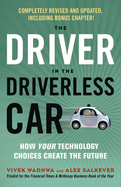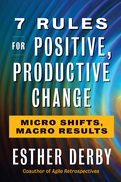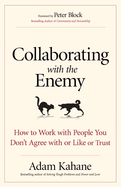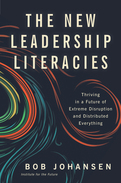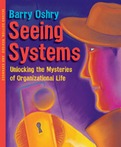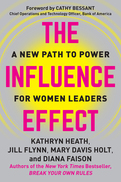Search Results: "Social Venture Networks/books/true-to-yourself.htm"
Results 349-354 of 362
Tech experts Vivek Wadhwa and Alex Salkever describe dozens of astonishing technological advances in this fascinating and thought-provoking book, which asks what kind of future lies ahead—Star Trek or Mad Max?
Breakthroughs such as personalized genomics, drones, self-driving vehicles, and artificial intelligence could make our lives healthier, safer, and easier. On the other hand, the same technologies raise the specter of a frightening future—eugenics, a jobless economy, a complete loss of privacy, and ever-worsening economic inequality.
Wadhwa says that we need to ask three questions about every emerging technology: Does it have the potential to benefit everyone equally? What are the risks and the rewards? And does it promote autonomy or dependence? This edition is updated throughout and includes a new chapter on quantum computing, which promises vastly increased processing times—and vastly increased security risks. In the end, our future is up to us; our hands may not be on the wheel, but we will decide the driverless car's destination.
Breakthroughs such as personalized genomics, drones, self-driving vehicles, and artificial intelligence could make our lives healthier, safer, and easier. On the other hand, the same technologies raise the specter of a frightening future—eugenics, a jobless economy, a complete loss of privacy, and ever-worsening economic inequality.
Wadhwa says that we need to ask three questions about every emerging technology: Does it have the potential to benefit everyone equally? What are the risks and the rewards? And does it promote autonomy or dependence? This edition is updated throughout and includes a new chapter on quantum computing, which promises vastly increased processing times—and vastly increased security risks. In the end, our future is up to us; our hands may not be on the wheel, but we will decide the driverless car's destination.
Change is difficult but essential—Esther Derby offers seven guidelines for change by attraction, an approach that draws people into the process so that instead of resisting change, they embrace it.
Even if you don't have change management in your job description, your job involves change. Change is a given as modern organizations respond to market and technology advances, make improvements, and evolve practices to meet new challenges. This is not a simple process on any level. Often, there is no indisputable right answer, and responding requires trial and error, learning and unlearning. Whatever you choose to do, it will interact with existing policies and structures in unpredictable ways. And there is, quite simply, a natural human resistance to being told to change.
Rather than creating more rigorous preconceived plans or imposing change by decree, agile software developer turned organizational change expert Esther Derby offers change by attraction, an approach that is adaptive and responsive and engages people in learning, evolving, and owning the new way. She presents a set of seven heuristics—guides to problem-solving—that empower people to achieve outcomes within broad constraints using their personal ingenuity and creativity.
When you work by attraction, you give space and support for people to feel the loss that comes with change and help them see what is valuable about the future you propose. Resistance fades because people feel there is nothing to push against—only something they want to move toward. Derby's approach clears the fog to provide a new way forward that honors people and creates safety for change.
Even if you don't have change management in your job description, your job involves change. Change is a given as modern organizations respond to market and technology advances, make improvements, and evolve practices to meet new challenges. This is not a simple process on any level. Often, there is no indisputable right answer, and responding requires trial and error, learning and unlearning. Whatever you choose to do, it will interact with existing policies and structures in unpredictable ways. And there is, quite simply, a natural human resistance to being told to change.
Rather than creating more rigorous preconceived plans or imposing change by decree, agile software developer turned organizational change expert Esther Derby offers change by attraction, an approach that is adaptive and responsive and engages people in learning, evolving, and owning the new way. She presents a set of seven heuristics—guides to problem-solving—that empower people to achieve outcomes within broad constraints using their personal ingenuity and creativity.
When you work by attraction, you give space and support for people to feel the loss that comes with change and help them see what is valuable about the future you propose. Resistance fades because people feel there is nothing to push against—only something they want to move toward. Derby's approach clears the fog to provide a new way forward that honors people and creates safety for change.
Collaboration is increasingly difficult and increasingly necessary
Often, to get something done that really matters to us, we need to work with people we don't agree with or like or trust. Adam Kahane has faced this challenge many times, working on big issues like democracy and jobs and climate change and on everyday issues in organizations and families. He has learned that our conventional understanding of collaboration—that it requires a harmonious team that agrees on where it's going, how it's going to get there, and who needs to do what—is wrong. Instead, we need a new approach to collaboration that embraces discord, experimentation, and genuine cocreation—which is exactly what Kahane provides in this groundbreaking and timely book.
Often, to get something done that really matters to us, we need to work with people we don't agree with or like or trust. Adam Kahane has faced this challenge many times, working on big issues like democracy and jobs and climate change and on everyday issues in organizations and families. He has learned that our conventional understanding of collaboration—that it requires a harmonious team that agrees on where it's going, how it's going to get there, and who needs to do what—is wrong. Instead, we need a new approach to collaboration that embraces discord, experimentation, and genuine cocreation—which is exactly what Kahane provides in this groundbreaking and timely book.
Over the next decade, today's connected world will be explosively more connected. Anything that can be distributed will be distributed: workforces, organizations, supply webs, and more. The tired practices of centralized organizations will become brittle in a future where authority is radically decentralized. Rigid hierarchies will give way to liquid structures. Most leaders—and most organizations—aren't ready for this future. Are you?
It's too late to catch up, but it's a great time to leapfrog. Noted futurist Bob Johansen goes beyond skills and competencies to propose five new leadership literacies—combinations of disciplines, practices, and worldviews—that will be needed to thrive in a VUCA world of increasing volatility, uncertainty, complexity, and ambiguity. This book shows how to (1) forecast likely futures so you can “look back” and make sure you're prepared now for the changes to come, (2) use low-risk gaming spaces to work through your concerns about the future and hone your leadership skills, (3) lead shape-shifting organizations where you can't just tell people what to do, (4) be a dynamic presence even when you're not there in person, and (5) keep your personal energy high and transmit that energy throughout your organization.
This visionary book provides a vivid description of the ideal talent profile for future leaders. It is written for current, rising star, and aspiring leaders; talent scouts searching for leaders; and executive coaches seeking a fresh view of how leaders will need to prepare. To get ready for this future, we will all need new leadership literacies.
It's too late to catch up, but it's a great time to leapfrog. Noted futurist Bob Johansen goes beyond skills and competencies to propose five new leadership literacies—combinations of disciplines, practices, and worldviews—that will be needed to thrive in a VUCA world of increasing volatility, uncertainty, complexity, and ambiguity. This book shows how to (1) forecast likely futures so you can “look back” and make sure you're prepared now for the changes to come, (2) use low-risk gaming spaces to work through your concerns about the future and hone your leadership skills, (3) lead shape-shifting organizations where you can't just tell people what to do, (4) be a dynamic presence even when you're not there in person, and (5) keep your personal energy high and transmit that energy throughout your organization.
This visionary book provides a vivid description of the ideal talent profile for future leaders. It is written for current, rising star, and aspiring leaders; talent scouts searching for leaders; and executive coaches seeking a fresh view of how leaders will need to prepare. To get ready for this future, we will all need new leadership literacies.
Seeing Systems
2007
In a wonderfully readable and fun way, SEEING SYSTEMS (over 30,000 copies sold) presents a unique and innovative theory of power dynamics that provides the reader with a new way of looking at, understanding, surviving, and prospering in the many systems of which we are part.In this extensively revised and updated edition of his classic book, Barry Oshry shows how we can transform “system blindness” into “system sight,” enabling us to live and work together in productive partnership. Based on more than thirty years of research and packed with illustrative cases and solid systems theory on human interaction, Seeing Systems provides a penetrating look at the dynamics of systems and a unique foundation for revolutionizing our understanding of system life. This new edition features an extensive new section on having the wisdom and courage to face and work with the reality of uncertainty, and a new epilogue describing how Oshry is currently using theater, blogs, and podcasts to extend his multi-pronged revolution aimed at transforming system blindness into system sight.
• New edition of a classic, revised and updated throughout, with a new section and a new epilogue
• Explains why so many efforts at creating satisfying and productive systems end in disappointment
• Offers an approach to improving organizational life that removes the personal biases that stymie so many change efforts
The Influence Effect
2017
Women hold over half of all professional jobs today, yet they represent just four percent of CEOs in the S&P 500. Even worse, that percentage has barely budged in a decade.
That's where The Influence Effect comes in. Based on recent research by the authors of the New York Times bestseller Break Your Own Rules, this book begins with the premise that when it comes to political savvy, what works for men at work won't work for women. Packed with the authors' coaching insights and their “Big Five” strategies designed specifically for female executives, this book guides women to break past political barriers and get right to what they really want—influence.
Authors Kathryn Heath, Jill Flynn, Mary Davis Holt, and Diana Faison make success far less complex, helping women overcome entrenched resistance to their ideas, create their own access points to power, and attract followers in a way that works for them. They present tools such as Influence Loops (to organically increase influence), Personal Scaffolding (to grow a groundswell of support), and Scenario Thinking (a savvy twist on strategic planning). These and other smart strategies finally allow women to succeed on their own terms.
Illustrated with dozens of engaging, real stories culled from the authors' many years of coaching experience, The Influence Effect moves women past the politics problem and offers a new path to power. Actually, it's more than a path—it's a runway—it frees women to take off in their careers on their own terms. The Influence Effect will work for women, not because gender barriers will no longer exist, but because they will no longer hold women back.
That's where The Influence Effect comes in. Based on recent research by the authors of the New York Times bestseller Break Your Own Rules, this book begins with the premise that when it comes to political savvy, what works for men at work won't work for women. Packed with the authors' coaching insights and their “Big Five” strategies designed specifically for female executives, this book guides women to break past political barriers and get right to what they really want—influence.
Authors Kathryn Heath, Jill Flynn, Mary Davis Holt, and Diana Faison make success far less complex, helping women overcome entrenched resistance to their ideas, create their own access points to power, and attract followers in a way that works for them. They present tools such as Influence Loops (to organically increase influence), Personal Scaffolding (to grow a groundswell of support), and Scenario Thinking (a savvy twist on strategic planning). These and other smart strategies finally allow women to succeed on their own terms.
Illustrated with dozens of engaging, real stories culled from the authors' many years of coaching experience, The Influence Effect moves women past the politics problem and offers a new path to power. Actually, it's more than a path—it's a runway—it frees women to take off in their careers on their own terms. The Influence Effect will work for women, not because gender barriers will no longer exist, but because they will no longer hold women back.


